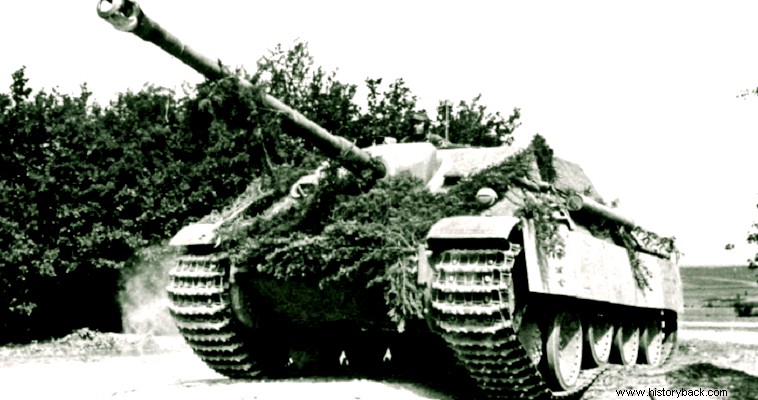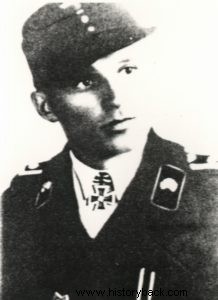
Hermann Bix served in the 4th Panzer Division (MPa). He was one of the successful tank crew chiefs of the German army. But his best moment was on March 22, 1945, when the war was effectively decided. Bix was born in Silesia in 1914. He enlisted in the army in 1935. In 1941 he found himself with the 4th BA in the USSR. He was particularly distinguished in October 1941 when he destroyed an entire Soviet motorized battalion with his tank (Pz III). He was wounded twice when his tank was destroyed and finished the war as an officer cadet.
In March 1945 the 4th Army was deployed in East Prussia, trapped in the enclave that had been created after the great Soviet offensive of January 1945. The division was facing a severe shortage of tanks, so six Jagdpanther tank destroyers were made available to them. strong> (panther hunter). These exceptional vehicles were based on the Pz V Panther tank but featured a long-barreled 88mm gun. instead of a 75 mm gun. of the chariot.
On the morning of March 22, Sergeant Bix and two other vehicles were at Preusisch Stargard (now Starogard Gdański, Poland) about 40 km south of Daczych (Gdansk). The mission of the three Jagdpanthers was to delay the Soviets enough to give the struggling German infantry time to retreat.
However, Bix's ulama was running short of ammunition. His own vehicle, the best equipped, had few shells for his famous 88-gauge cannon. So the other two vehicles when they ran out of ammunition left. Bix's vehicle was left alone, hidden behind a pile of trash.
“As the fog began to lift I could make out two Russian tanks approaching very cautiously on a hill in front of us. They reached a distance of 1,200 m. It was neither a T-34 nor a KV-1. They were American (Sherman). I knew from experience that they could be neutralized from this distance easily. We burned them both and the Ivans (the Soviets) did not dare to move for a while," he said.
Crisis time
German tank crews who no longer had tanks acted as infantry flanking Bix's "panther hunter". Half an hour after the destruction of the first two Soviet tanks two more appeared but these too were soon reduced to burning wreckage. But things were getting difficult. Bix's gunner informed him that they only had 20 armor-piercing and 5 explosive rounds. At the same time their infantry colleagues retreated. Bix's vehicle was alone.
“Suddenly I saw them carrying two anti-tank guns. We opened fire with explosive shells. Pieces of wood shook in the air. They had brought fake guns to force us to fire and to locate our position... We moved the vehicle a little further back. But from there I could only see by sticking my head out of the window. But when I looked I couldn't believe my eyes... I saw a phalanx moving swiftly towards our position. The lead chariot was at 1,200 m. Chariots were moving in front and supply vehicles behind…” Bix described the scene.
Bix with his experience quickly surveyed the terrain and calculated the distances. Then the Jagdpanther put. But his gunner missed. It hit a large tree which was cut in half and fell onto the advancing Soviet tank with the branches. Apparently its driver could not see, obstructed by the branches, and the chariot ended up in a ditch immobilized.
The next Soviet tank advanced towards the first and stopped. But he had not spotted the Jagdpanther. The Soviet tanks turned all the turrets and blinded them. "We had to hit it right as we had few missiles and if one of their tanks wasn't destroyed it would have been very bad for us," Bix said.
"He ordered fire on the chariot that was in the middle of the phalanx and it was immediately engulfed in flames with the first shot. Then we hit the last tank of the phalanx. In flames too. Immediately after that we started shooting at the rest as if we were doing shooting practice," he said.
Within 10 minutes, 11 Soviet tanks were destroyed. Some Soviet vehicles that were not destroyed also fell into ditches as they tried to turn and escape as visibility was reduced by the fires and smoke of the burning tanks.
The last opponent and the escape
"When I ordered my gunner to hit the supply vehicles too he told me we only had two rounds left ", said Bix who after this statement gave the order to retreat as other Soviet tanks were approaching.
"A Russian tank was 300 m from us to the right of the village". The Soviet tank spotted them as I retreated out of the village. Bix realized this and immediately ordered a turn. But the ground was muddy and the heavy Jagdpanther turned very slowly.
The Soviet Guide he also tried to get his chariot into a better position but he also had trouble with the mud and the back of his chariot began to sink. So his cannon aimed high. So the Jagdpanther caught up and turned, now having the Soviet tank in front of its killer gun.
Soviet charioteers realized they had no hope and jumped out, abandoning their chariot as the German shell struck and destroyed it. Bix immediately ordered his driver to move the Jagdpanther at top speed. After adventures Bix and his men were saved. They survived the war. He enlisted in the West German army in 1956 in which he served until 1970. After all, he had destroyed 16 Soviet tanks in about two hours. He died in 1986.

Herman Bix.
